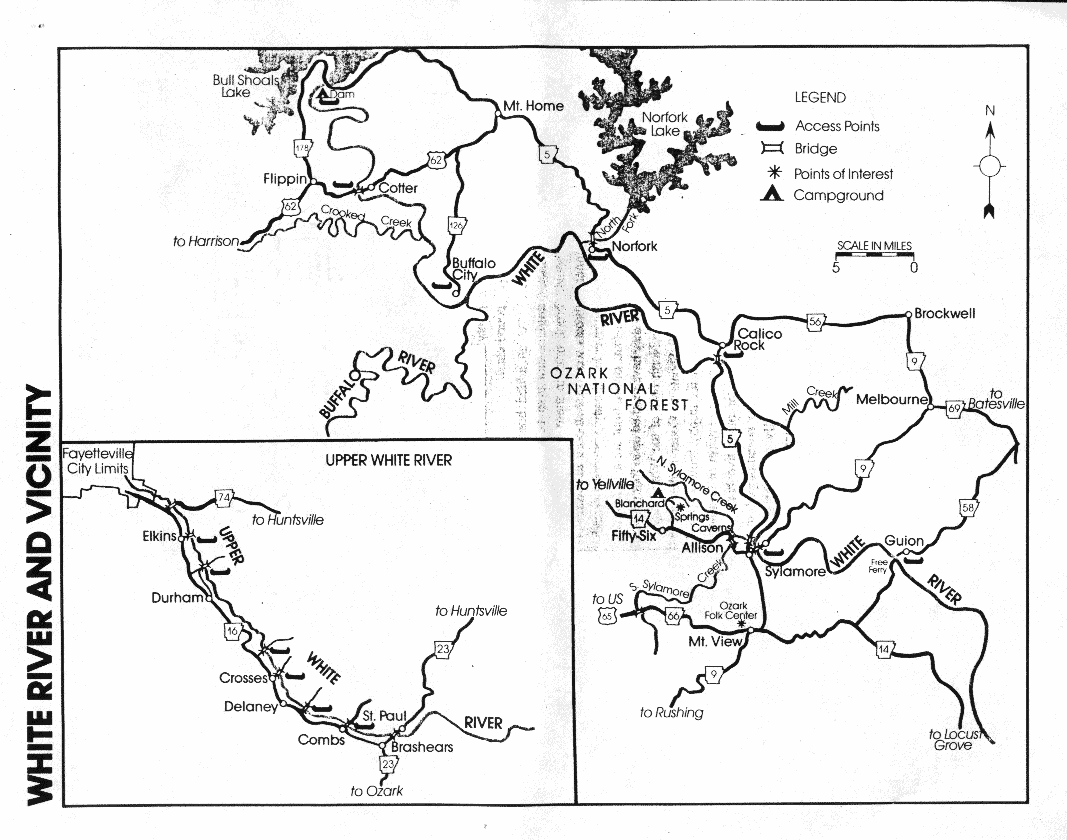White River

White River map
To a casual reader of maps, the
White River appears mostly, well, indecisive. It flows west in its headwaters
region before turning north in the Fayetteville-Springdale area. On toward
Eureka Springs, the river bends back to
the east, then wanders up through
southern Missouri before reentering
Arkansas and angling to the southeast
past Cotter, Calico Rock, and Batesville. At Newport, the stream makes an
abrupt turn to the south and flows some
257 miles in that direction before joining up with thc Mississippi River.
In this 720-mile journey, the White
undergoes several transformations. It
begins as a small, mountain stream
(complete with rapids), and ends up as a
broad, meandering waterway serving
the barge and towboat industry. In between, the river's flow is interrupted by
at least eight dams, six in Arkansas and
two more in Missouri. The largest of
these, Bull Shoals, is responsible
for converting what had been a warm-water fishery into one of the nation's
premier stretches of trout habitat. Today this cold-water section of the White
River is among the state's major tourist
destinations .
But the White River is more than an
attraction for outdoor recreation-types.
As it passes through or alongside nearly
a fourth (18) of Arkansas's 75 counties,
it exerts a steady though sometimes
subtle influence on a vast portion of.the
state.
SECTION DESCRIBED
Entire length of 720 miles, with emphasis on headwaters region and trout fishing section.
CHARACTERISTICS
The first 31 miles of the White River are
similar to the beginning stretches of
other Ozark streams, fast and furious
in the wet months, and comparatively
calm the rest of the year. In this upper
stretch above the first impoundment, Lake Sequoyah, the stream offers a
series of pools and shoals with overhanging trees, tight turns, and gravel
bottoms. While Arkansas 16 is seldom
more than a quarter of a mile away, it
goes virtually unnoticed by floaters.
The bluffs, forests, and quiet pastures
hold visitors' interest.
The next "floatable" section of the
White begins many miles downstream,
right at the base of Bull Shoals Dam.
Here the river is considerably larger
and, because of the hydro-power discharges from deep within the lake, very
cold, just right, in fact, for rainbow,
brown, and cutthroat trout. Each year
thousands of people try their luck with
these fish, and numerous guide ser-
vices, outfitters, trout docks, and re-
sorts have been established to help out.
Also contributing to their success is the
Arkansas Game and Fish Commission
which annually stocks great quantities
of trout into the stream. Many of these
are caught fairly soon after their release, but others manage to hide out
year after year, getting bigger all the
time. Some get exceptionally large,
like the 19 pound, 1 ounce rainbow or
the 33 pound, 8 ounce brown trout
which are discussed in the "fishing"
section.
But trout are only one part of the
White River picture. There's the scenery itself, featuring some of the best
bluffs in all of the Ozarks. Others remember the river by the thin layer of fog
suspended delicately above the stream
each morning around sunrise. And not
to be overlooked are the famous 'shore
lunches" on handy gravel bars, cooked
up on the spot by experienced out-
fitters.
The trout section of the river
stretches all the way to Guion, or a distance of about 90 miles. Flowing into
the White along the route are two
superb smallmouth streams, Crooked
Creek and the Buffalo River and another fine trout stream_the North
Fork River The latter offers a scenic
six-mile float between Norfork Dam
and the town of Norfork.
There are numerous ways to get to
know the White. One extreme, and
the choice of thousands of vacationers
every year, is to hire a guide and a
johnboat, relax in a deck chair, and
head for a fishing hole. Another ex-
treme is to emulate the annual Boy
Scout pilgrimage by putting a canoe in
at Bull Shoals State Park and paddling
like crazy all the way to Batesville, a
distance of 120 miles.
No matter how they get on the river,
visitors need to remember that the
stream is subject to sudden fluctuations
because of power generation at the
dam. When all the turbines are in operation, the White River can become bankfull and verv swift. At normal operating
levels, however, the stream's shoals
and pools provide an ideal combination
for a memorable fishing trip.
SEASONS
The White's upper reaches are strictly
seasonal, with the late October through
April/May period traditionally the best
time for float trips. Below Bull Shoals
Dam, the White River is a year-round
float stream, with some of the best fishing reported during the winter months.
ACCESS POINTS
Launch sites for the White are too numerous to list. The Game and Fish
Commission has constructed many access points downstream from Bull
Shoals, and the Arkansas State Parks
Division has a handy launch ramp at
Bull Shoals State Park. In addition,
many of the resorts along the river have
developed launching areas for their
guests.
SCENERY
People have been commenting on the
beauty of the White River since at least
1819 when explorer Henry Rowe
Schoolcraft said of the stream: "It
unites a current which possesses the purity of crystal, with a smooth and gentle
flow, and the most imposing diversified, and delightful scenery . . .Our
canoe often seemed as if suspended in
the air, such is the remarkable transpar
ency of the water ".
Today's visitors will not be in quite
the wilderness that Schoolcraft experienced, but there's still plenty of good
scenery — towering bluffs, wildflowers, thickly forested hillsides, and
lots of wildlife.
FISHING
T
he upper White River with its assortment of bass (smallmouth. largemouth,
rock, and Kentucky), catfish (channel,
blue, and flathead), and sunfish should
satisfy nearly any angler. Spinner-
baits, crawfish imitators, and skirted
jigs (with pork tails) are recommended,
along with minnows, crawfish, and
other natural baits.
Below Bull Shoals Dam, the White
River takes on an entirely different
character. Here it is one of the most famous float fishing streams in the world.
And with good reason. Probably more
rainbow trout are caught here each year
than in any other trout stream in
America. The Game and Fish Commission stocks hundreds of thousands of
rainbows in the White annually, and
more than 90 percent of them are caught
each year by anglers who come here
from all corners of the globe.
Brown trout? Well, let the figures
speak for themselves. In 1972, Gordon
Lackey landed a monster brown weighing 31 lbs. 8 ozs. This stood as the North
American record until fellow guide
Leon Waggoner landed a 331/2 lb. giant
in 1977, now just mere ounces under
the world record brown. Missouri an-
gler Tony Salamon landed a 30 lb. 8 oz.
leviathan in 1986 that set a new world
line class record for 6-pound-test line.
Very few browns grow that large, of
course. But frankly, 5-10 pounders are
common, and anglers have a good
chance of landing an 11-20 pound
trophy. And, yes, a few 20 pound plus
monsters are usually corralled each
year.
Although White River rainbows
don't approach North American record
size, the river still boasts the 19 lb. 1 oz.
Arkansas state record. Ten pound fish
are considered large, but there are
plenty of real thoroughbreds in the 2-6
pound class.
As an added bonus, White River
anglers can also find cutthroat and
brook trout in these fine waters. Cutthroats were first stocked in 1983, but
the river has already produced 9-pound-
plus fish. Brook trout are a rare catch,
but they have reached up to four pounds
in the North Fork of the White.
Bull Shoals to Cotter is the stretch
best known for trophy browns. Many
are taken on live crayfish or sculpins,
but a variety of other live baits and
artificials can also be employed successfully, especially at night since
brown trout are nocturnal feeders. Fly-
fishing is extremely popular on the
White during low water periods, but
most anglers opt for the standard White
River rig—a 16- to 20-foot flat-bottom boat.

ARKANSAS RIVERS & CREEKS
Big Piney Creek
Buffalo River
Caddo River
Cadron Creek
Cossatot River
Crooked Creek
Eleven Point River
Illinois Bayou
Kings River
Little Missouri River
Little Red River
Mulberry River
Ouachita River
Saline River
Spring River
Strawberry River
White River



![[CleanWeb Approved Site]](cwlogo.gif)
This page hosted by  Get your own Free Home Page
Get your own Free Home Page
© 1997, 1998 arkoutdoors




![[CleanWeb Approved Site]](cwlogo.gif)
 Get your own Free Home Page
Get your own Free Home Page
